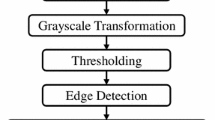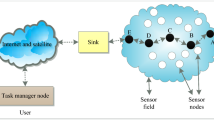Abstract
The water level provides critically important information for disaster mitigation and water resource management. Image-based recognition and processing systems employed to monitor flow in channels/rivers have become a progressive technique. However, whether the observational goal can be achieved by utilizing a low image resolution is questionable. In this study, a closed-circuit television surveillance camera with a low image resolution, which was installed by the local government in an irrigation and drainage channel, is analyzed. To demonstrate the availability and capability of a low imaging resolution, the statistical errors between image recognition/manual identification and measured water levels in six field experiments were compared. The root-mean-square error, mean absolute error , and mean absolute percentage error values ranged from 0.05 to 0.18 m, from 0.04 to 0.20 m, and from 4.23% to 18.29%, respectively, for image recognition. The results indicate that the technique of image recognition and processing achieves automatic monitoring goals and acceptable error. Furthermore, there are some on-site environmental factors and image processing techniques to be explored. The results indicated that the shadows of a large range of buildings, uneven brightness, watermarks formed on the riverbank, glared images, and water level measurements by image recognition and processing caused inaccuracies. In this study, the double identification region used to detect the water level yielded better results than the single identification region. The Gaussian filter best preserves the edge information and eliminates noise. Increasing the resolution of the original image fivefold achieves a better balance between preserving edge information and eliminating noise, which was the most suitable for water level measurement.













Similar content being viewed by others
References
Cheng HY, Wang H (2012) Design of trash rack water level measurement and control system based on ultrasonic. Adv Mater Res 542–543:194–197
Elias M, Kehl C, Schneider D (2019) Photogrammetric water level determination using smartphone technology. Photogramm Rec 34(166):198–223
Eltner A, Elias M, Sardemann H, Spieler D (2018) Automatic image-based water stage measurement for long-term observations in ungauged catchments. Water Resour Res 54:10362–10371
Eltner A, Bressan PO, Akiyama T, Goncalves WN, Junior JM (2021) Using deep learning for automatic water stage measurements. Water Resour Res 57:e2020WR027608
Gao A, Wu S, Wang F, Wu X, Xu P, Yu L, Zhu S (2019) A newly developed unmanned aerial vehicle (UAV) imagery based technology for field measurement of water level. Water 11(1):124
Gilmore TE, Birgand F, Chapman KW (2013) Source and magnitude of error in an inexpensive image-based water level measurement system. J Hydrol 496:178–186
Greswell R, Ellis P, Cuthbert M, Durand V (2009) The design and application of an inexpensive pressure monitoring system for shallow water level measurement, tensiometry and piezometry. J Hydrol 373(3):416–425
Herzog A, Stahl K, Blauhut V, Weiler M (2022) Measuring zero water level in stream reaches: a comparison of an image-based versus a conventional method. Hydrol Process 36:e14658
Hies T, Parasuraman SB, Eikaas HS, Tan KM (2012) Enhanced water-level detection by image processing. In: 10th International conference hydoinform, HIC 2012 Hamburg, Germany
Hu M, Zhai G, Li D, Li H, Liu M, Tang W, Chen Y (2018) Influence of image resolution on the performance of remote breathing rate measurement using thermal imaging technique. Infrared Phys Technol 93:63–69
Isidoro JMGP, Martins R, Carvalho RF, de Lima JLMP (2021) A high-frequency low-cost technique for measuring small-scale water level fluctuations using computer vision. Measurement 180:109477
Jafari NH, Li X, Chen Q, Le CY, Betzer LP, Liang Y (2021) Real-time water level monitoring using live cameras and computer vision techniques. Comput Geosci 147:104642
Kearney W, Mariotti G, Deegan LA, Fagherazzi S (2017) Stage-discharge relationship in tidal channels. Limnol Oceanogr Meth 15:394–407
Kim S, Choi H, Park D, Baek E, Kim J (2018) Water level response measurement in a steel cylindrical liquid storage tank using image filter processing under seismic excitation. Mech Syst Signal Process 101:274–291
Kuo LC, Tai CC (2021) Automatic water-level measurement system for confined-space applications. Rev Sci Instrum 92:085001
Kuswidiyanto LW, Nugroho AP, Jati AW, Wismoyo GW (2021) Automatic water level monitoring system based on computer vision technology for supporting the irrigation modernization. IOP Conf Ser Earth Environ Sci 686(1):012055
Leduc P, Ashmore P, Sjogren D (2018) Technical note: stage and water width measurement of a mountain stream using a simple time-lapse camera. Hydrol Earth Syst Sci 22(1):1–11
Leigh C, Boulton A, Courtwright J, Fritz K (2016) Ecological research and management of intermittent rivers: an historical review and future directions. Freshw Biol 61(8):1181–1199
Lin YT, Yang MD, Han JY, Su YF, Jang JH (2020) Quantifying flood water levels using image-based volunteered geographic information. Remote Sens 12(4):706
Loizou K, Koutroulis E (2016) Water level sensing: state of the art review and performance evaluation of a low-cost measurement system. Measurement 89:204–214
Muhadi NA, Abdullah AF, Bejo SK, Mahadi MR, Mijic A (2021) Deep learning sematic segmentation for water level estimation using surveillance camera. Appl Sci 11(20):9691
Noto S, Tauro F, Petroselli A, Apollonio C, Botter G, Grimaldi S (2022) Low-cost stage-camera system for continuous water-level monitoring in ephemeral streams. Hydrol Sci J 67(9):1439–1448
Paris A, de Pavia RD, de Silva JS, Moreira DM, Calmant S, Garambois PA, Collischonn W, Bonnet MP, Seyler F (2016) Stage-discharge rating curves based on satellite altimetry and modeled discharge in the Amazon basin. Water Resour Res 52:3787–3814
Qiao G, Yang M, Wang H (2022) A water level measurement approach based on YOLOv5s. Sensors 22(10):3714
Rukundo O, Cao H (2012) Nearest neighbor value interpolation. Int Jf Adv Comput Sci Appl 3(4):1–6
Sabbantini L, Palma L, Belli A, Sini F, Pierleoni P (2021) A computer vision system for staff gauge in river flooding monitor. Inventions 6(4):79
Seibert J, Strobl B, Etter S, Hummer P, van Meerveld HJ (2019) Virtual staff gauges for crowd-based stream level observations. Front Earth Sci 7:70
The MathWorks Inc (2022) MATLAB version: 9.13.0 (R2022b). Natick, Massachusetts
Toprak A, Güler I (2007) Impulse noise reduction in medical images with the use of switch mode fuzzy adaptive median filter. Digit Signal Process 17(4):711–723
Vanden Boomen RL, Yu Z, Liao Q (2021) Application deep learning for imaging-based stream gauging. Water Resour Res 57:e2021WR029980
Wilson CL, Watson CI, Paek EG (2000) Effect of resolution and image quality on combined optical and neural network fingerprint matching. Pattern Recognit 33(2):317–331
Yang CH, Wang CY, Yang JX (2014) Applying image recording and identification for measuring water stages to prevent flood hazards. Nat Hazard 74:737–754
Yoon GW, Kim SW, Lee YW, Won JS (2013) Measurement of the water level in reservoirs from TerraSAR-X SAR interferometry and amplitude images. Remote Sens Lett 4(5):446–454
Young DS, Hart JK, Martinez K (2015) Image analysis techniques to estimate river discharge using time-lapse cameras in remote locations. Comput Geosci 76:1–10
Zhang Z, Zhou Y, Liu H, Gao H (2019a) In-situ water level measurement using NIR-imaging video camera. Flow Meas Instrum 67:95–106
Zhang Z, Zhou Y, Liu H, Zhang L, Wang H (2019b) Visual measurement of water level under complex illumination conditions. Sensors 19(19):4141
Zhou X, Reve M, Modi P, Shiozawa T, Yamazaki D (2022) Correction of river bathymetry parameters using the stage-discharge rating curve. Water Resour Res 58:e2021WR031226
Acknowledgements
This study was partially supported by the National Science and Technology Council (NSC), Taiwan, under grant no. 109-2625-M-239-002. The financial support is greatly appreciated.
Author information
Authors and Affiliations
Corresponding author
Ethics declarations
Conflict of interest
The authors declare that they have no conflict of interest.
Rights and permissions
Springer Nature or its licensor (e.g. a society or other partner) holds exclusive rights to this article under a publishing agreement with the author(s) or other rightsholder(s); author self-archiving of the accepted manuscript version of this article is solely governed by the terms of such publishing agreement and applicable law.
About this article
Cite this article
Liu, WC., Chung, CK. & Huang, WC. Image-based recognition and processing system for monitoring water levels in an irrigation and drainage channel. Paddy Water Environ 21, 417–431 (2023). https://doi.org/10.1007/s10333-023-00935-9
Received:
Revised:
Accepted:
Published:
Issue Date:
DOI: https://doi.org/10.1007/s10333-023-00935-9




